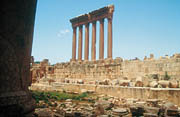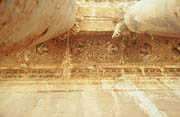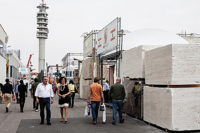

The stereobate or platform that once held the Temple of Jupiter in Baalbek, Lebanon called for such a specification, but the architects and engineers who built it in the first century BC left no indication of how they accomplished such a massive construction challenge. The limestone blocks were quarried about a quarter of a mile away from the construction site and made up the lower course of the foundation. How they were transported and positioned so precisely remains a mystery. There are no records of whether the Romans were capable of such an engineering masterpiece and debates go on as to whether the platform was built by the Romans or, according to some local folklore, whether it was built by a pantheon of superhuman giants.
Archaeologists suggest that Baalbek had its beginnings as a stopping place for traders and their caravans between Palmyra and Damascus in Syria and the Levantine coastal cities. Excavations indicate the site was occupied as early as 2300 BC by the Phoenicians, a sea-faring people known in the Bible as the Canaanites who worshipped the god Baal. When Alexander the Great marched through the Beqa'a Valley on the way to Damascus in 334 BC, Baalbek was known as Heliopolis, the "city of the sun," the name given to this important religious center by the Ptolemies of Egypt, the rulers of the time.
When Julius Caesar made Baalbek a Roman colony in 27 BC, its purpose as a religious center continued, but with great Roman exuberance, and the golden age began. Construction on three major and several minor temples began and was to continue for the next 150 years. Jupiter, the most important of the Roman gods, was the principle deity to preside over the monumental city until the Roman Empire converted to Christianity. Building materials for the temples included the local limestone and pink granite from Aswan in Egypt that was used for the columns supporting the porticos and facades.
Baalbek today is a small town with a population of about 12,000 in the Beqa'a Valley between the Lebanon and Anti-Lebanon mountain ranges. The 50-mile drive from Beruit makes it a fairly easy day trip to see this World Heritage Site - one of the ancient world's greatest architectural and engineering achievements and an impressive demonstration of the artistry of the master stone carvers of the time.
Once you've bought your ticket and navigated the aggressive souvenir and snack vendors who line the entrance gate, the climb up the monumental staircase and through the Hexagonal Court brings you to The Great Court and what looks like a vast jumble of rocks and bits and pieces of columns, capitals, cornices and the crumbling remains of cyclopean masonry walls. On closer inspection, the bits and pieces begin to take on new meaning, and the imagination kicks in. The Great Court was surrounded on three sides by 12 magnificent exedrae or benches that were each preceded by a portico. In this area, sacred meals were taken, and cult followers communed with the priests.
Walking between great granite Corinthian columns into alcoves richly decorated with now-empty niches, images of the statues of the gods and goddesses that once watched over the cults who worshipped here come to life. Mercury the messenger, Diana the hunter, Ceres the goddess of wheat, Vulcan the divine smithy all sing their siren song if you listen very closely. On through the vast Great Court and what's left of the sacrificial altars, it doesn't take much to conjure up visions of robed priests and sacred white bulls waiting to become the day's offering to the gods.
Up yet another monumental staircase is what remains of the great Temple of Jupiter, the Roman's supreme deity. It consisted of a cella or sanctuary which held a statue of Jupiter and was surrounded by a portico supported by 54 granite columns that stood 75 feet high and were 7 feet in diameter - the largest in the world. Six of those columns with the architrave still in place are all that remain of the Temple of Jupiter, the greatest religious building of the classical world.
Earthquakes in 1158, 1203, 1664 and 1759 damaged or destroyed many of the structures and temples of Baalbek. Thieves and recyclers also took their toll. Over the years, the temple stones were removed and recycled into a Byzantine basilica (now completely gone) and later into an Arab fortress. In about 560 AD, the Byzantine Emperor Justinian appropriated eight of the columns for the basilica of Hagia Sophia in Constantinople (Istanbul).
While the Temple of Jupiter today is mostly visualized in one's imagination, the smaller Temple of Bacchus stands remarkably preserved. The best view is from the south side of the Temple of Jupiter where the foundation stones, the columns and portico, and what remains of the frieze can all be seen in perspective. Completed in 150 AD and dedicated to the god of wine and good times, this is the best-preserved structure within the ruins complex.
The entrance stairway on the east side rises in three flights of steps and brings you into the portico. The portico's 42 columns are 62 feet high and support a richly carved frieze of lions and bulls. Parts of the frieze that have broken away and survived the fall from that great height lie amidst a rose garden that has been planted next to the temple. The ceiling of the portico is of carved limestone decorated with scenes of the gods in action--Vulcan with his hammer, Diana with her bow and quiver of arrows, a winged Victory. The danger in studying the ceiling carvings is in getting a stiff neck looking up or running into a column or another tourist.
When the temple was in use as a place of worship, the inside must have been a dark and mysterious place. It was likely to be lit by smoky oil lamps, with incense burning and shadows casting a divine manifestation on the statues of the gods and goddesses.
The inner side walls and the cella are decorated with Corinthian columns that form pilasters and two-story niches that once held statues of the gods and goddesses. Nine steps lead from the main sanctuary up to the shrine where the cult statue stood. Stone carvings throughout the interior hint at the deity to whom the temple is dedicated. Clusters of grapes and vines, and cavorting nymphs tell tales of ancient good times and celebrations.
The ruins that tourists visit today are there thanks to the Arabs who built fortifications in such a way that the temples were preserved, and to German archeologists who began excavation and preservation work in the late 19th century. After World War I, French scholars continued the work. Over the following decades, the temples were restored to as close to their original splendor as was possible. We are privileged to visit such well preserved sites like Baalbek only because of the dedicated work of historians, archaeologists and scholars and the governments and institutions that support them and their work.
It only seemed fitting that we celebrate our explorations of the Temple of Bacchus with a visit to the Kasara Winery. In 1906, a cave system carved out of the mountain by the Romans was rediscovered and is now used by the winery as natural wine cellars. The red wines are produced from cinsaut and grenache grapes and the whites from savignon blanc and chardonnay grapes. Not the greatest wine, but not bad either. They also produce arak, an anise-flavored drink much like French Pernod or Greek ouzo, that is mixed with water and ice. Arak is one of those "acquired" tastes that I never really acquired. But a couple of bottles of their white wine found their way into our luggage and, once home, we revisited the great Temple of Bacchus -- at least in our imaginations.


